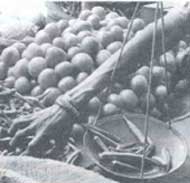The niece`s tale
 Development can spawn curious offspring. The prospect of involving rural women in a refresher course on the importance of maintaining vegetable gardens surely qualifies as one of these. And that's precisely what Growing Together, a 28-minute film by Joss Brooks, purports to do.
Development can spawn curious offspring. The prospect of involving rural women in a refresher course on the importance of maintaining vegetable gardens surely qualifies as one of these. And that's precisely what Growing Together, a 28-minute film by Joss Brooks, purports to do.
But this anecdote hides a larger irony. Often, films on the Green Revolution are so taken up by those flowing fields caught against the mellow evening sun that they forget to look for other truths -- one of these being the very prominent impact of the Green Revolution on the diet of the people, especially the rural population.
In 1964, India produced 12 million tonnes of wheat on 14 million hectare of land. By 1990, farmers were hoeing in 55 million tonnes of wheat from about 23 million ha. But overemphasis on wheat and rice production, and cutting out legumes in favour of cereals in India, has led to a massive downswing in protein and iron consumption by a majority of the population.
Even the extra income generated in rural areas does not always translate into a beef-up in the nutritional status of the rural poor. Boiled rice, raw onions and green chillies and/or salt is what contitutes a whole meal, popped down the hatch 2 or 3 times a day. The fact that the luscious apple or the innocuous tomato considerably strains an already shoestring budget means that one keeps going back to rice and onions. Point of the story: low dietary intake.
Rural women and children are the worst affected by the absence of a wholesome meal. A majority of Indian women suffer from anaemia and other vitamin deficiencies. And it was to put some good food into women and growing children that some voluntary organisations began to promote the concept of nutrition gardens in villages. This is where Joss Brooks comes in.
The film, probably intended as a training module by voluntary health care workers, takes the form of a structured narrative. A health worker on a visit to a relative notices the unbalanced diet of her kin and recounts her experiences of another village where the women had adopted nutrition gardens into the rhythms of their daily life. She tells her aunt of a demonstration garden where a variety of crops were being grown. There is a visit to nearby villages, and the niece holds forth on how women had used their own knowledge and creativity in the nutrition gardens.
The film then turns to a group of women using waste water to produce about 35 different varieties of vegetables in their community nutrition gardens: the success of this venture spurred the women to set up their own vegetable gardens.
The storyline, tunefully interspersed with songs, proceeds on its redemptive path amidst women going about their innumerable household chores, a naturalist touch which should go down well with its intended audience. Liberal sprinklings of wisdom further decorate the journey: how even a small patch of land can be transformed into a nutrition garden, kicking alive the soil with organic waste, and how to take care of small hitches such as dealing with pests and preventing cattle and other animals from disrupting the little patches of green.
Forming local seed banks and moneylending cooperatives, and associations that can deal with various problems faced by rural women, are some of the other development linkages that are woven around the main story. Nutrition gardens become a means to a larger end: how women can be more self-sufficient.
